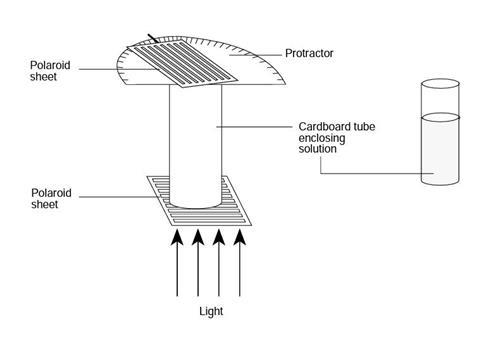Investigate the stereospecificity of terrestrial life in this experiment that explores how to find life, in dust
This experiment should take around two hours.
Equipment
Materials per group Dust:
- Sand
- Vermiculite
- D-fructose Each sample should contain ca 5 g D-fructose. (Alternatively, amino acids can be used.)
- For calibrating polarimeter: 10 g D-fructose, deionised water
Equipment per group
- Items from the junk list, including:
- Sealing wax
- Rubber bands
- Rubber tubing
- Glass tubing and rods (various)
- Protractor
- Paper
- Test tubes
- Test tube holder and rack
- Beakers (various)
- Weighing bottles (various, flat bottomed)
- Filter funnel
- Filter paper
- Measuring cylinders, 25 cm3 and 100 cm3
- Petri dishes
- Pasteur pipettes
- Optical filters (coloured, polarizing, clear, diffuse)
- Clamps and stands
- Corks
- Copper wire
- Light source
- Wash bottle
- Mirrors (small)
- Bunsen burner
- Plastic gloves
- Safety glasses
Health, safety and technical notes
- Read our standard health and safety guidance here.
- Wear eye protection.
- This is an open-ended problem-solving activity, so the guidance given here is necessarily incomplete.
Commentary
Some students may need help in remembering that the building blocks of proteins and carbohydrates – amino acids and sugars – are chiral and therefore stereospecific. They may also need help in recalling how a polarimeter works. However, the instruction to test a physical property of organic compounds from living sources, plus the presence of optical filters in the equipment, prompted most students to test for optical activity by constructing a polarimeter. This problem has been used successfully in competitions.
Possible approach
The hand-outs, including a list of the contents of the kits, can be given to groups the previous day. The main challenge must be seen as the construction of an arrangement capable of giving a reliable estimate of the optical activity in the sample. A possible design for a polarimeter is sketched below; a way of measuring the angle of rotation must be devised.

Possible extension
If this method was used to analyse dust from a meteoric crater for signs of extra terrestrial life, what assumptions would the students have to make to analyse their results?
Evaluation
This problem was set as a competition and marks were awarded as follows.
- Marks were awarded for the construction of the polarimeter.
- Marks were awarded for use and demonstration of optical activity in the dust.
- Marks were deducted for hints that were given.
Notes
This resource is part of a collection of problem-solving activities, designed to engage learners in small group work. Find out how to use these resources, and obtain a list of suggested ‘junk items’ here.
Downloads
Only dust - is there a sign of life?
Experiment | PDF, Size 55.44 kb
Additional information
The resources were originally published in the book In Search of More Solutions.


















No comments yet